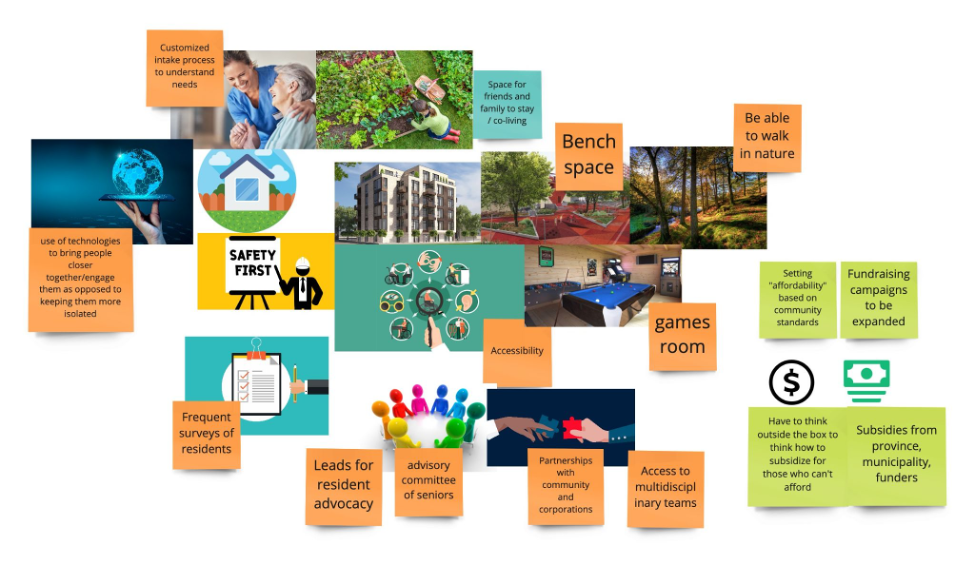Prototyping with St. Joseph’s Continuing Care Centre
In June 2021, we did some early prototyping with St. Joseph’s Continuing Care Centre, a Building with Mission demonstration site. A small group of interested stakeholders came together to prototype housing ideas for older adults that emerged from a problem and opportunity mapping workshop that had been held several weeks earlier.
We began by discussing the major themes that had emerged in the previous workshop, and then prioritized a theme to move forward into prototyping. The eight major themes included:
REIMAGINED RELATIONSHIPS: The way that healthcare has been traditionally understood is reimagined. Staff are deeply valued and have flexibility to be fluid in their role
TAILORED APPROACHES: Customized and tailored approaches to housing and care that meet people's needs as they change
FAMILY FEELING: Housing replicates a family environment where families are considered part of the care team and have full access to their loved ones. Family and resident satisfaction is prioritized
AFFORDABLE OPTIONS: Affordability makes homes and private rooms accessible to all through appropriate funding models such as RGI, market rent, and something in between
CARE CAMPUS: Supportive housing model that includes a campus of care with all services in one place such as personal care, wellness, meals, and differently-abled connections
TECHNOLOGY AND INNOVATION: Use of technology and other innovative approaches to fill gaps in housing and care
ACTIVE PROGRAMMING: Intentional life and enjoyment activities and programming as well as outdoor green spaces
INTERGENERATIONAL COMMUNITY: Strong community involvement and participation in the housing and care with an emphasis on intergenerational programs
The themes were then turned into “How Might We” statements (HMWs) . The “how” is solutions-oriented, the “might” encourages optimism, and the “we” is collaborative. By turning themes into HMWs, you can more clearly see where the opportunities are to improve this experience. The HMWs included:
How might we bring everything seniors need into one place?
HMW build a tailored campus of care?
HMW develop customized and tailored approaches to housing and care that meet people's needs as they change?
Participants then generated as many ideas as they could for their HMWs and discussed the connections between the ideas before coming up with one big idea to prototype. In Miro, an interactive white boarding tool, groups used images to build a visual representation of their ideas.
Prototype One: Campus of Care
This prototype responded to the problem statement “How might we bring everything seniors need into one place?” It is visualized as a Campus of Care that emphasizes a patient-centered model. It was inspired by the site location that St. Joseph’s Continuing Care Centre has in mind for a housing development - a site adjacent to an existing long-term care home, a hospital and an affordable seniors housing apartment.
This Campus of Care would provide numerous medical services and customized levels of care that correspond to seniors' various needs and levels of independence. Some features of the project would include ground floor space for a clinic or pharmacy, a physio gym, communal spaces where residents can eat meals together and host family, and lots of green space. Another important aspect would be the presence of several multi-bedroom units that allow seniors and their family members to live together.
One of the most important aspects of this Campus of Care was the flexible service model. Rather than having seniors move to different levels of care throughout the building or the campus as their needs change, staff would meet seniors where they are and care for them in their existing units. This would be made possible by drawing on the staff available at the adjacent sites and through the use of technology to support remote monitoring.
It was believed all of this could be delivered at a cost less than existing care models and therefore a proposal would have to be brought to funders to seek more flexible funding than is traditionally available.
Prototype Two: Accommodating seniors throughout their lifetime
This prototype responded to the problem statement “How might we develop customized and tailored approaches to housing and care that meet people's needs as they change?” It features ways to adapt senior’s housing to be able to accommodate older adults as their needs change throughout their lifetime. Examples include customized intake processes to understand seniors’ needs, an advisory committee and feedback sessions to ensure senior voices are heard, and the use of technology to bring people together rather than leave them isolated.
There was a significant importance attributed to the “accessibility” of the living space, whether that implied a physical space that could be easily configured to meet the health needs of the residents, or in terms of how care is provided (e.g. is there language interpretation). The prototype also encouraged partnerships with external groups and corporations to help serve residents as best as possible, such as providing timely and accessible transportation.
The physical building would include rooftop greenspace, games rooms, and space for family and friends to co-live through the lens of promoting safe living areas.
This prototype placed a strong emphasis on accessibility and resident advocacy.
Lastly, groups presented their HMWs and prototypes. Feedback was shared by the group and recorded on a feedback grid. In terms of next steps, St. Joseph’s Continuing Care Centre will continue to gather feedback and iterate on prototypes before coming up with a plan for implementation. They will then present the prototypes to the Board for approval, communicate plans back to the broader group, and zero-in on funding-related conversations.
They will also be maintaining connection with the Building with Mission team through check-ins and providing a review of the draft Playbook. Going forward, the St. Joseph’s Continuing Care Centre team is committed to challenging its assumptions by bringing in missing perspectives and engaging more seniors at every step in the process.


